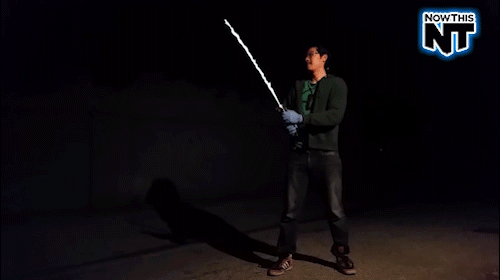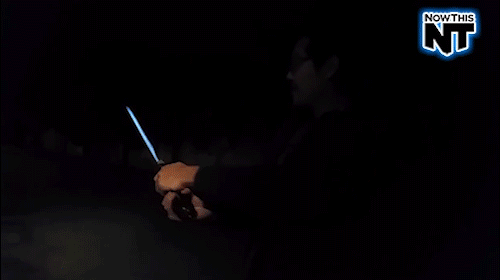Glowing Bandages Can Reduce The Chances Of Antibiotic-resistant Bugs

Glowing bandages can reduce the chances of antibiotic-resistant bugs
More Posts from Curiositytherover and Others

Titan Beyond the Rings
“The discovery of the odd arrangement — previously seen only in liquid helium, densely packed granules, and other non-biological systems — is more than a scientific curiosity, according to the statement. It could help lead to the development of optical circuits, light detectors, and other devices that transmit light with the efficiency of a crystal and the flexibility of a liquid.”

Total Recall Sounds Great, But Some Things Should Be Forgotten
Imagine never again forgetting where you parked your car, or that last item you had on your grocery list, or why you walked into this room anyway. If you trust media stories about research currently under way at Defense Advanced Research Projects Agency (DARPA) to build an implantable device to restore memory, you might not have to worry about these memory lapses in the future.

Answer Time from Space!
I’m on day 321 of my #YearInSpace, and today I surpassed 500 days in space total. Let’s chat! Sat., Feb. 13 at 1:45 p.m. ET.


You can grab and fold this drone without hurting yourself





REAL LIFE LIGHTSABER ALERT!
The guy that made the real life version of Mjolnir has crafted another real version of a fictional weapon: a functioning lightsaber. Allen Pan made the fabled Jedi weapon out of an igniter, butane, methanol and acetone which creates a focused pillar of flame. It even makes real sounds! Now, of course this isn’t a conventional lightsaber and you shouldn’t try this at home but it’s awesome that somebody finally accomplished something close! GIVE THIS MAN A GRANT.

Well, it had to come to an end some time. There’s been a whole lot of buzz over KIC 8462852 - a star located about 1,500 light-years away between the Cygnus and Lyre constellations of our Milky Way galaxy. It’s displaying such weird behaviour, one scientist even threw the possibility of an advanced alien civilisation building a giant Dyson sphere nearby.
But new research has come up with the most plausible explanation yet for KIC 8462852’s weirdness - a barrage of comet fragments are spinning in a tight orbit around the star. […] But despite the evidence, they’re still not ready to discount the alien megastructure idea entirely. “We can’t really say it is, or is not,” said Marengo. “But what the star is doing is very strange. It’s interesting when you have phenomena like that - typically it means there’s some new physical explanation or a new concept to be discovered.”
Continue Reading.

One thing we’re always doing as a species is expanding our knowledge of the heavens. We send out probes, robots, satellites, spacecraft, all to map out and add to our ever-expanding picture of what the Universe looks like.
But what if that picture suddenly became smaller? That is exactly what happened when new data from the Planck satellite tightened our previous notions of the observable universe, shrinking its area by 0.7%.
If you’ve never realized, we don’t actually see all of the stars in the Universe. If we did, night time sky would be a whole lot brighter. Instead, we see everything within a particular radius, the particle horizon. Any particle of light emitted outside that particle horizon is too far to have reached us.
So if we want to know just how large the observable universe is, we just have to figure out the distance between us and that particle horizon, right?
As it turns out, not quite.
The universe, specifically spacetime, is continuously expanding, with points in the universe moving further apart. This not only changes the distance between objects but also how fast light is moving in the universe.
The movement of spacetime has an effect on which photons reach us and can be observed.
So how do you calculate the radius? Back in 2003, scientists came up with an equation that took an event called “the recombination” as a reference point in the universe’s history. They combined that with the rate of the expansion of the universe and several other factors, in the end coming up with a number.
Back in 2003, that number was a radius of 45.66 billion light-years. Now, new data revealed a far more accurate number: 45.34 billion light-years.
“A difference of 320 million light-years might be peanuts on the cosmic scale, but it does make our knowable universe a little bit cozier,” Nick Tomasello from the University of the Sciences in Philadelphia writes over at Medium.
The study has been accepted for publication in an upcoming edition of Advances in Astrophysics.
A lot of people live in fear because they haven’t figured out how you’re going to react when faced with a certain set of circumstances. I’ve come to terms with this by looking deeply into whatever makes me fearful - what are the key elements that get the hairs up on the back of my neck - and then figuring out what I can do about it.
Chris Hadfield (via fyp-science)
does anyone know of any good science blogs? I want to follow more.
-
 comatose-blue liked this · 9 years ago
comatose-blue liked this · 9 years ago -
 true-shit-man reblogged this · 9 years ago
true-shit-man reblogged this · 9 years ago -
 ryanisnogood liked this · 9 years ago
ryanisnogood liked this · 9 years ago -
 curiositytherover reblogged this · 9 years ago
curiositytherover reblogged this · 9 years ago -
 soysaucebase liked this · 9 years ago
soysaucebase liked this · 9 years ago -
 xcziel reblogged this · 9 years ago
xcziel reblogged this · 9 years ago -
 televisomnia reblogged this · 9 years ago
televisomnia reblogged this · 9 years ago -
 losthawaiiansf liked this · 9 years ago
losthawaiiansf liked this · 9 years ago -
 engadget reblogged this · 9 years ago
engadget reblogged this · 9 years ago
